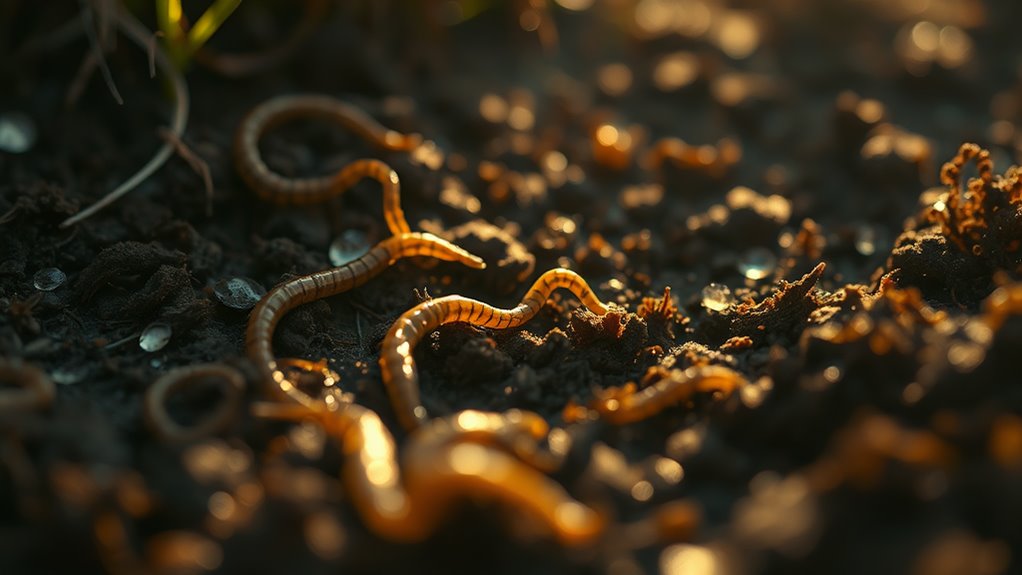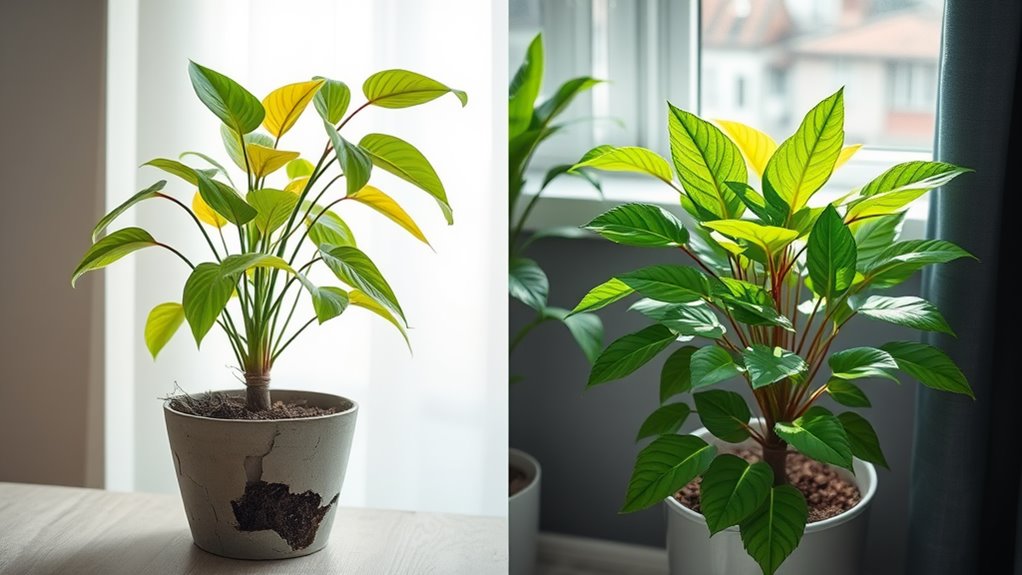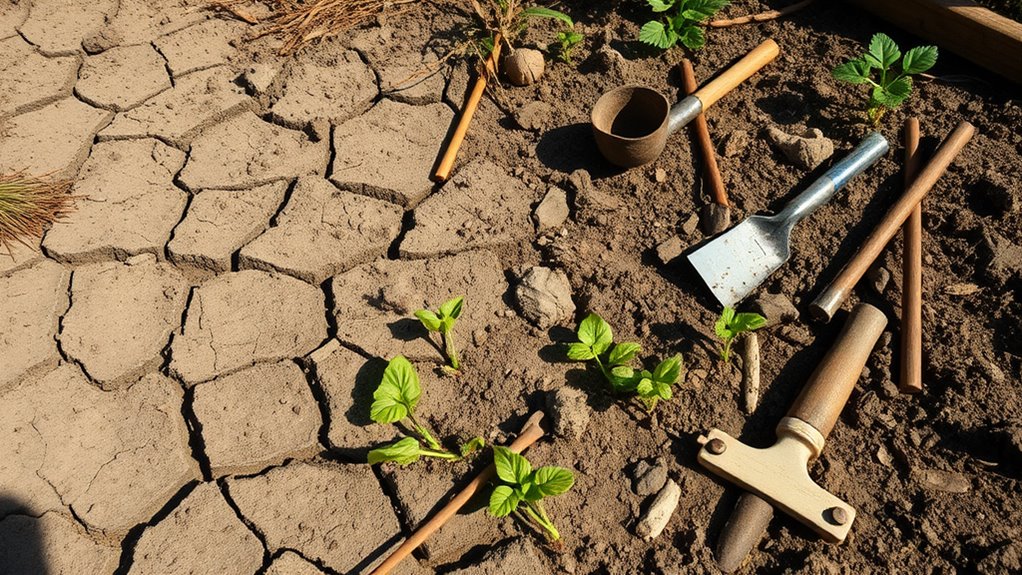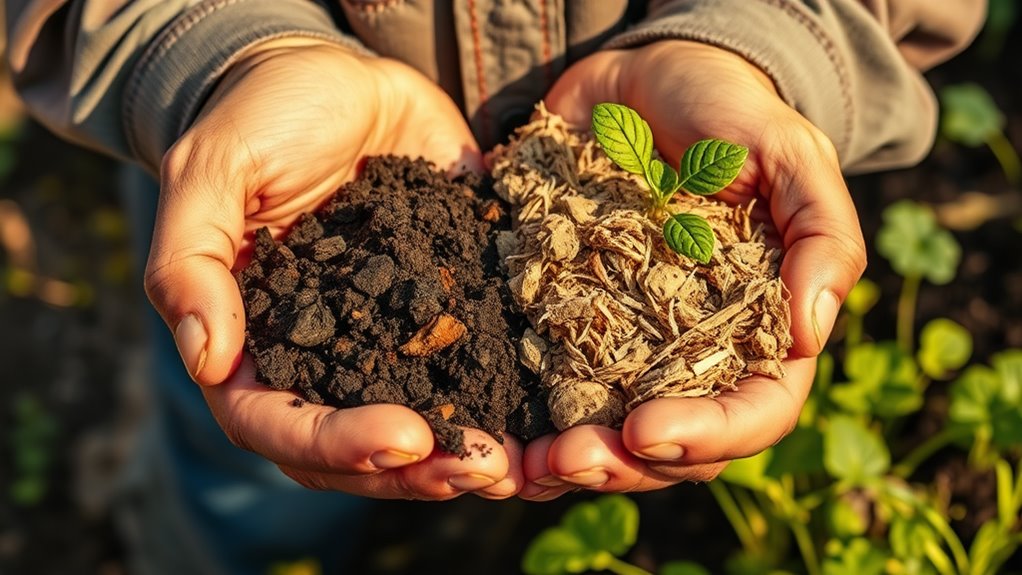Your Soil Is Trying to Tell You Something – Are You Listening.
Your soil’s color—dark for nutrient-rich organic matter or gray for poor drainage—reveals key health clues. Feel its texture to spot sand’s grittiness, silt’s smoothness, or clay’s stickiness, and check for compaction that blocks water infiltration. Watch drainage patterns for waterlogging risks, pH levels for nutrient imbalances, and erosion signs like rills. By tuning into these indicators, you’re set to unlock deeper strategies for thriving gardens.
Key Takeaways
- Observe soil color: Dark hues signal high organic matter, while gray tones indicate poor drainage.
- Feel soil texture: Grittiness suggests sand for fast drainage, stickiness indicates clay prone to compaction.
- Check water infiltration: Slow absorption after rain points to compacted soil needing aeration.
- Test soil pH: Imbalances cause nutrient deficiencies, like yellowing leaves from iron lack.
- Watch for erosion signs: Rills or exposed roots warn of soil loss, urging protective measures.
Signs of Soil Color Variations
When you examine soil, you’ll notice color variations that signal key factors like organic matter content, mineral composition, or drainage conditions. Understanding these signs can help debunk soil myths for better gardening practices.
Soil signs, such as dark brown or black hues, indicate high organic matter, fostering nutrient-rich environments for plant growth.
Reddish tones reveal iron oxides, pointing to well-oxygenated, freely draining soils.
Gray or mottled colors signal water saturation and reduced conditions, potentially limiting root development.
By interpreting these color indicators, gardeners can enhance soil health for improved plant growth and garden sustainability.
Indicators of Soil Texture and Structure
Building on your observations of soil colors, you’ll assess texture and structure as vital indicators of soil health. Texture determines particle sizes—sand, silt, clay—while structure reveals particle aggregation.
-
Feel soil between fingers to identify sand’s grittiness, silt’s smoothness, or clay’s stickiness.
-
Classify texture using the ribbon test for clay content.
-
Observe aggregates for granular, blocky, or prismatic structures.
-
Check soil porosity by noting air spaces in clumps.
-
Evaluate stability by how aggregates resist breakdown when handled.
Understanding these aspects can help improve crop yields by optimizing soil conditions for better plant growth.
To further enhance garden success, consider performing soil testing to identify and remedy any underlying issues based on your texture and structure assessments.
Clues From Drainage and Water Retention
Drainage and water retention offer essential insights into soil health, as you evaluate how quickly water infiltrates and how long it holds moisture. You can observe this by timing how fast water puddles vanish after rain; fast drainage suggests sandy soils, while slow retention indicates clay types that risk waterlogging. Use this table to compare common soil characteristics:
| Soil Type | Drainage Rate | Water Retention |
|---|---|---|
| Sandy | Fast | Low |
| Loamy | Moderate | Moderate |
| Clay | Slow | High |
| Silty | Moderate | High |
| Peaty | Very Slow | Very High |
For instance, if your soil drains poorly, add organic matter to improve it; if it dries out quickly, use mulch to boost retention. Furthermore, incorporating mulch benefits can help maintain soil moisture and support a thriving garden ecosystem. Always monitor these signs to optimize growth. Additionally, you can enhance your soil using backyard solutions like leaves and compost from your yard for better long-term results.
Ph Level Imbalances in Soil
Soil pH imbalances directly influence nutrient availability in your soil, much like drainage affects water movement. Additionally, universal soil prep methods emphasize essential techniques for adapting to various environmental conditions to maintain balanced pH.
You’re managing a scale from 0 to 14, where values below 7 indicate acidity and above 7 show alkalinity, impacting essential element solubility.
- Acidic conditions mobilize aluminum, potentially harming roots.
- Alkaline environments bind iron and manganese, reducing uptake.
- Erosion and leaching shift pH levels over time.
- Regular testing with probes ensures accurate readings.
- Amendments like gypsum correct imbalances by altering soil chemistry.
By incorporating natural soil preparation techniques, you can enhance your harvest without relying on fertilizers for healthier plants and greater yields.
Symptoms of Nutrient Deficiencies
As you manage your soil, you notice yellowing leaves as a primary symptom of nutrient deficiencies, signaling issues like nitrogen shortages.
This visual cue helps you identify when plants lack vital elements for photosynthesis.
You also see stunted growth, where insufficient nutrients hinder root and stem development.
One way to prevent common mistakes is by regularly testing and amending your soil to ensure balanced nutrient levels.
By following practical tips, you can effectively manage and prevent these issues.
Yellowing Leaves
If your plants’ leaves turn yellow, this symptom often signals nutrient deficiencies like nitrogen or iron shortages. You’ll notice patterns that pinpoint the issue, helping you act quickly to restore soil health.
-
Nitrogen deficiency: Causes uniform yellowing on older leaves, indicating poor overall growth support.
-
Iron deficiency: Leads to interveinal chlorosis, where veins stay green but areas between yellow.
-
Magnesium shortage: Results in yellowing between veins on lower leaves, affecting photosynthesis.
-
Potassium lack: Produces yellow edges and tips, signaling reduced nutrient uptake.
-
Sulfur deficiency: Shows as uniform yellowing on new growth, often in acidic soils.
Stunted Growth
Stunted growth in your plants signals nutrient deficiencies that limit development, often resulting in shorter stems and smaller yields.
This symptom typically arises from insufficient nitrogen, which you need for vegetative growth, leading to pale, stunted plants.
Phosphorus deficiency affects energy transfer, causing poor root development and delayed maturity.
Potassium lack disrupts water regulation, resulting in weak stems and increased disease susceptibility.
Other culprits include magnesium or calcium shortages, impairing cell function.
You diagnose by conducting soil tests for macronutrients and micronutrients like iron or zinc, then amend with targeted fertilizers to restore balance and boost health.
Signs of Soil Compaction
You notice surface crusting on your soil, a clear indicator of compaction that hardens the top layer.
This condition reduces water infiltration, preventing moisture from penetrating deeply.
Consequently, you observe stunted root growth, limiting your plants’ access to essential nutrients and space.
Surface Crusting Signs
Surface crusting, a key indicator of soil compaction, forms when raindrop impact or heavy machinery packs the topsoil, creating a dense layer that hinders water absorption and root penetration.
You can spot this issue early by examining your soil’s surface for telltale signs.
- Hard, sealed layer: You’ll feel a tough crust that resists breaking.
- Cracked appearance: Notice fine cracks forming after drying.
- Poor seedling emergence: Seeds struggle to push through the barrier.
- Reduced soil porosity: The layer limits air pockets essential for roots.
- Erosion risk increase: Loose particles wash away more easily.
Poor Water Infiltration
Poor water infiltration stems from soil compaction, leaving water to pool on the surface rather than penetrate deeply. You might notice standing water after rain, indicating reduced pore spaces that block downward flow.
Compacted soil often results from heavy machinery or foot traffic, increasing density and slowing infiltration rates. Check for this by probing the soil; if it’s firm and resists entry, action’s needed.
Measure infiltration by timing how long water takes to soak in—if over 10 minutes, compaction’s likely. Address it through aeration to restore soil structure and improve water movement.
Stunted Root Growth
Stunted root growth often signals soil compaction, where dense layers hinder root penetration and expansion.
You’re dealing with a common issue that affects your plants’ access to water, nutrients, and oxygen.
-
Observe stunted plants: Your crops show poor height and yield due to restricted roots.
-
Feel the soil hardness: You can’t easily insert a tool more than a few inches deep.
-
Note surface roots****: Roots spread out on top instead of delving down.
-
Detect poor drainage****: Water pools, indicating compacted layers below.
-
Monitor nutrient deficiency****: Leaves yellow because roots can’t absorb essentials effectively.
Addressing this boosts your soil’s health quickly.
Markers of Biological Activity
Markers of biological activity, such as microbial biomass and enzyme levels, offer reliable indicators of soil’s vitality.
You measure microbial biomass using techniques like fumigation-extraction to quantify the thriving microbial community that decomposes organic matter and cycles nutrients.
Enzyme levels, such as beta-glucosidase, signal the soil’s metabolic efficiency in breaking down substrates.
By tracking these markers, you’re evaluating ecosystem health; elevated biomass and enzymes denote robust activity, while declines prompt action.
This precise monitoring empowers you to enhance soil fertility, supporting sustainable practices without unnecessary interventions.
For instance, integrating compost ingredients from kitchen waste can further elevate microbial biomass and enzyme levels in your soil.
Additionally, incorporating kitchen scraps from organic composting can provide extra nutrients to boost microbial biomass and enzyme levels.
Warnings of Soil Erosion
Soil erosion reveals itself through visible signs like rills, gullies, and sediment buildup, which you can detect early to protect soil integrity.
You’re responsible for spotting these warnings to maintain land health.
- Check for rills forming on slopes, indicating surface runoff.
- Identify gullies deepening after heavy rains, signaling severe loss.
- Monitor sediment accumulation in streams, showing topsoil displacement.
- Observe exposed roots and subsoil, revealing nutrient depletion.
- Track reduced water infiltration rates, confirming compaction issues.





